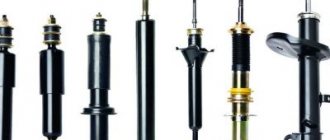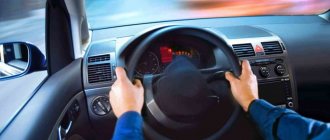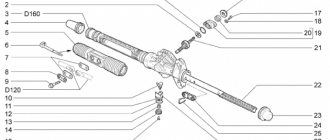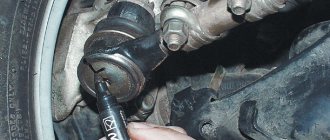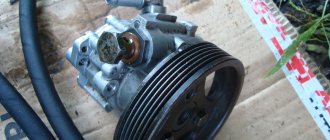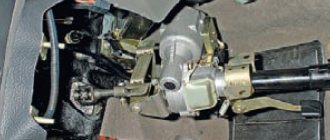Extraneous sounds during vehicle operation are very disturbing. It is better to identify the causes of malfunctions as quickly as possible and eliminate them at the initial stage, otherwise car repairs may become more expensive. Let's figure out why noises/clicks may appear when turning the steering wheel.
The steering design of modern Lada cars (Priora, Kalina, Granta, Largus, Vesta, Niva and XRAY) is practically the same. Therefore, the possible causes of malfunctions are similar:
- The tie rod ball joint nuts are loose (No. 2 in photo No. 1).
- The gap between the steering rack stop and the nut has been increased (photo No. 2). Tighten the steering rack.
- The steering rack fastening has become loose (No. 1, 19, 21 photo No. 3).
- The outer constant velocity joints (CV joints) are worn out (No. 1 photo No. 4).
- Increased axial play of the wheel (severe wear of the front wheel bearings No. 3 photo No. 5 or loosening of the hub nut No. 6)
- The fastening parts of the front suspension have become loose, photo No. 6 (fastening the stabilizer bar to the body, the front suspension steering knuckle to the strut, the nuts of silent blocks of the suspension arms, braces, strut support).
- The shock absorber strut support bearing (No. 4 photo No. 7) or the rubber support element is worn out.
- The suspension spring broke (No. 6 Photo No. 7).
- The wheel mounting bolts have become loose, photo No. 8.
According to the AvtoVAZ technical bulletin dated December 15, 2015, the cause of a squeak when the steering wheel rotates may be an insulating gasket that needs to be cut.
Have you encountered a knocking or squeaking sound when turning the steering wheel? What was the cause of your problem? Also, the cause of extraneous noise when turning the steering wheel may be play in the crosspiece of the steering shaft or a gearless electric power steering.
A creaking sound when turning the steering wheel is the first sign of a car malfunction, to which the motorist must pay attention. This kind of breakdown can threaten the life and health of the motorist and his passengers. If a malfunction is noticed, the first thing to do is carry out diagnostics and contact a car service center.
The steering wheel is the main control mechanism of the car, and if you hear any extraneous noise in it, you must definitely eliminate it. It is important to avoid the phrase “it will endure”, since when subjected to wear, a broken part can harm neighboring mechanisms. As a result of this, the working mechanisms may jam, and while driving, this breakdown can cost the lives of the driver and passengers. Therefore, it would not be superfluous to conduct a full inspection and computer diagnostics of all parts of the car.
There are many reasons for the occurrence of extraneous noise; when turning the steering wheel, it is important to take into account that this is a complex mechanism, which means that breakdowns will have a different nature. The noise may also vary depending on whether the steering wheel has hydraulic or electric steering assist. In any case, you need to carry out high-quality diagnostics at the nearest car service center. To make the work easier, the specialist should explain in detail the nature of the noise and under what circumstances it occurs. It is necessary to perform a number of actions when driving and also when parking the car.
Let's dwell on the topic of diagnostics. How to explain to a mechanic exactly what the problem is with the steering mechanism? First of all, you need to try to answer the following questions:
- What is the frequency of the squeak and its character?
- Is there a difference in road surface?
- When turning in which direction does the noise occur?
- Does the noise go away when weather conditions change?
Why power steering is no longer used in new cars
Power steering has long been part of the automotive industry.
Such equipment allows motorists to maneuver the steering wheel without any problems. Older models did not have power steering, so steering was much harder. All power steering can be divided into types. They differ in type of design and principle of operation. Previously, hydraulic boosters gained great popularity, and then they began to be replaced by electric boosters. Now the pressing question is why automakers no longer install hydraulic boosters on new models. Electric power steering can be combined with various autopilot systems
Electric power steering on modern vehicles has many advantages over hydraulic power steering. And this is explained by several factors. Firstly, such devices have less weight. Secondly, they do not consume a lot of energy. In addition, they are distinguished by a convenient layout and the absence of the need to carry out routine maintenance work.
Electric boosters can be combined with various autopilot systems. This may include automatic parking or a system for keeping the car in one lane. Recently, such designs have gained another advantage - they are cheaper to produce. As you can see, electric power steering has a whole list of advantages. Despite this, many motorists note the shortcomings and refuse to use such systems in their vehicles. As a rule, criticism of electric boosters can be heard from the older generation of motorists.
A more modern type of amplifier is spreading in the passenger car market. Despite this, hydraulic boosters are still in demand
The main drawback, according to many, is inaccurate and artificial feedback. However, developments do not stand still and experts are constantly trying to improve electric amplifiers, so such problems have long been solved. A more modern type of amplifier is spreading in the passenger car market. Despite this, hydraulic boosters are still in demand. They are used for trucks and special equipment. This is due to the fact that the hydraulic booster is able to withstand higher loads.
If you prefer carefree movement from one point to another, then you should choose electric power steering
Motorists who are accustomed to driving vehicles comfortably and feeling feedback from the car should pay attention to classic hydraulic boosters. Such a device does not require expensive maintenance. The car owner should only periodically check the fluid level in the system and monitor the condition of the oil in the expansion tank. If any breakdowns occur in the amplifier, you will not need to spend a large amount of money on repairs. If you prefer carefree movement from one point to another, then you should choose electric power steering. Such equipment requires less attention. The owner will not need to monitor the fluid in the system. Note that cars equipped with electric power steering are less responsive to driver inputs. This does not mean that the car does not obey and drives as it wants - there is simply no feedback from the steering wheel.
Bottom line. Electric power steering is gradually replacing hydraulic power steering from the market. And this is explained by the advantage of the former over the latter. They do not require maintenance and have a convenient layout.
Basic faults
The electromechanical power steering system of the Lada Vesta has its own shortcomings, which then do not manifest themselves in the best way - sometimes even while driving. By the way, the EUR Vesta has a peculiarity - at speeds above 70 km/h it may seem that the car is “floating”, but in fact it is the sensors that react so sensitively to steering movements.
When you start the engine, the yellow steering wheel icon with an exclamation mark will light up on the dashboard for three seconds. This is normal - a normal sensor check. But if after three seconds the icon does not burn out, this will mean that the system has failed, and you should not start driving - at a minimum, you should connect to the diagnostic connector to find out what the problem is.
The electric booster may turn off while driving due to a short circuit in the wiring. It is usually preceded by a slight knocking sound in the steering wheel - if you feel this kind of rattling, be prepared to slow down and stop. Disabling the EUR while driving at a decent speed leads to the steering wheel spontaneously turning to the side, and the car can eventually slide into the adjacent or even oncoming lane.
A shorted wiring is caused by the fact that the harness under the hood is not protected from moving parts and ends up rubbing against the steering driveshaft. You can prevent the problem if you remove the battery terminal, harness and cover the wires with a corrugated tube - both from ingress of large amounts of moisture and from mechanical damage. If a breakdown occurs, replace the blown EUR fuse.
If you cannot diagnose it yourself, contact an authorized dealer and insist on a real check. As the experience of Vesta owners shows, the official dealer checked the suspension, released the car with assurances that everything was in order, and did not look for the real reason for the rattling in the steering wheel. Defend your point of view so that the defective power steering unit is checked and replaced.
Lada Vesta cars are equipped with a steering system with a safety steering column, an electromechanical booster and an adjustment mechanism for tilt and reach.
A rack-and-pinion steering mechanism with a constant gear ratio is mounted on the front suspension subframe.
The steering drive consists of two horizontal steering rods and levers on the steering knuckles. The length of each steering linkage rod is adjusted by rotating the inner tip and secured with a locknut.
Figure 1-1 – Steering: 1 – driver airbag module (MNAPB); 2 – steering wheel; 3 – block of steering column switches; 4 – lower steering column casing; 5 – ignition switch; 6 – upper steering column casing;
Steering column (Fig. 5.1) with a mechanism for adjusting its tilt position and an anti-theft device in the ignition switch that blocks the steering shaft from turning. The steering column brackets, attached with nuts to the brackets on the body, are pivotally connected to the steering column itself, this allows you to change the angle of the column.
Rice. 5.1. Steering column with electric power steering: 1 – intermediate shaft; 2 – upper cardan joint of the intermediate shaft; 3 – electric amplifier; 4 – steering column position lock lever; 5 – bracket for fastening the steering column casing; 6 – movable part of the steering column;
7 – splined tip of the steering shaft; 8 – ignition switch (lock); 9 – steering column adjustment mechanism; 10 – bracket for fastening the adjustment mechanism; 11 – fixed part of the steering column; 12 – bracket for fastening the electric amplifier; 13 – electric amplifier control unit; 14 – lower cardan joint of the intermediate shaft
On the movable part of the steering column there are controls for headlights, turn indicators, washer and windshield wiper.
Electromechanical power steering (electric power steering, EMURU) reduces the force on the steering wheel, thereby making it easier to control the car. If the electric booster fails, the car retains full controllability, but the force on the steering wheel increases slightly.
New Lada: How to turn on the rear wiper on a Kalina
The electric booster works as follows. When the driver turns the steering wheel, a moment occurs on the steering input shaft, resulting in a mismatch between the input and output shafts. An elastic element (torsion bar) located between the shafts is twisted at an angle proportional to the magnitude of the moment. The magnitude of this angle is determined by a torque sensor.
When the torque on the input shaft exceeds the minimum specified value, the electric amplifier control unit sends a control signal to the electric motor windings to create the required additional torque on the shaft. The signal to the windings is supplied taking into account the signals from the rotor position sensor and the torque sensor. As the vehicle speed increases, the torque created by the EMURU decreases proportionally.
In the instrument cluster there is a fault indicator for the electric power steering (orange). The warning light comes on when the ignition is turned on and should go out after the engine is started. If the warning light comes on while the engine is running, it indicates a malfunction of the electric power steering; the electric power steering is switched off and the force on the steering wheel increases sharply. In this case, you need to contact a car service as soon as possible to diagnose and repair the electric amplifier.
The electric amplifier may also turn off for reasons not related to a malfunction of the amplifier mechanism itself:
– when the on-board network voltage decreases;
– at low idle speed of the car engine;
– in the absence of a signal about the vehicle speed;
– when the car is parked for more than 5 minutes with the engine running, whose crankshaft speed is above 1500 rpm.
The intermediate shaft is connected to the output shaft of the electric booster and to the steering shaft by cardan joints. The intermediate shaft consists of two parts, upper and lower, connected by splines. In the event of a frontal collision of the car with any obstacle, the lower part of the intermediate shaft enters the upper part, which makes it possible to reduce the length of the intermediate shaft and thereby cause less harm to the driver.
For greater safety, the axis of the steering shaft is shifted relative to the axis of the steering mechanism: in the event of a frontal collision of a car, the lower part of the intermediate shaft, due to universal joints, moves relative to the upper one, which allows the shaft to “fold” sideways.
The steering mechanism is rack and pinion type with a constant gear ratio and is fixed to the front suspension subframe with rigid brackets 10 (Fig. 5.2). Carter 5 of the steering mechanism is cast from aluminum alloy. The crankcase contains a helical drive gear (pinion shaft), which meshes with the rack. The rack has oblique teeth.
Rice. 5.2. Steering mechanism: 1 – outer tie rod end; 2 – hexagon of thrust; 3 – thrust cover; 4 – steering gear shaft; 5 – steering gear housing; 6 – hinge of the outer rod end; 7 – lock nut of the rod end;
The steering drive includes two integral tie rods and swing arms on the front suspension knuckles.
The tie rods are attached to the steering rack and to the steering knuckles of the front suspension with ball joints. The steering rods are secured against rotation in the tips 1 (see Fig. 5.2) by locknuts 7. By rotating the steering rod in the inner ball joint relative to the outer tip 1, the toe-in of the steered wheels is adjusted.
The ball joint 6 of the outer tip is covered with a rubber protective cover (boot) to protect it from dirt. The outer tip forms a non-separable structure with the hinge, therefore, if the hinge fails, the tip should be replaced.
Steering wheel with driver airbag. The central pad of the steering wheel contains buttons for activating the horn; in the optional version, the cruise control control switches are located on the left spoke of the steering wheel, and the multimedia system is located on the right spoke.
The issue of safety is not only about seat belts, airbags and electronic systems. After all, it is better to prevent an accident than to try to minimize its consequences. That is why all the machine’s systems must work correctly, and the build quality must be at its best so that unexpected breakdowns do not occur along the way.
Why are the calipers knocking on the Lada Vesta?
The front and rear calipers on the Lada Vesta rattle for the same reasons, so the “treatment” schemes are the same. There are three objective sources of caliper noise.
Pad wear
Owners monitor the degree of wear of the pads (friction linings) when they change the brake fluid or every 2-3 thousand km.
Pad wear. Photo source: https://pricep-vlg.ru/remont-svoimi-rukami/stuchit-support-chto-delat/
What affects the abrasion of an element:
- The quality of the material depends on the manufacturer.
- Driving style - frequent and sharp braking accelerates depreciation.
- Operating conditions - off-road, sand, water, mountain roads - bring the time to replace the pads closer.
- The serviceability of the brake system - when the car has serviceable working cylinders and caliper guides, the wear of the pads occurs evenly.
- Anti-lock braking system - with it, the pads wear out more slowly.
- Transmission type - in cars with automatic transmission, the pads wear out earlier, because stopping is possible only when you press the pedal. On the “mechanics” they often brake the engine - the part wears less.
- Pad rigidity. Soft linings wear out faster, but the disc remains intact. Hard ones are the opposite: the disc suffers, but the pads hold up. The hardness of the pads is selected according to the series: sport, comfort, classic.
- Transport congestion - transporting heavy luggage and towing trailers has a detrimental effect on the condition of the friction layer.
How to determine the degree of depreciation:
- In move. If at low speed, hitting a speed bump, or driving on a dirt road, a knocking sound is heard, and disappears when braking, this indicates serious wear of the Vesta caliper. But similar symptoms plus beating in the pedal occur when the brake pads wear out or the disc is deformed - here replacing the calipers will not solve the knocking problem. When the pads are worn out, a characteristic squeaking pedal also appears.
- Visually. Remove the wheel and inspect the assembly. If the linings are worn out, replace the spare part.
Blame the guides
An important element of the brake system - the caliper guides in the Lada Vesta - can also cause the part to knock.
Caliper guides in Lada Vesta. Photo source: https://krsk.au.ru/14177557-napravljajuschie-supporta-lada-vesta-largus/
There are two problems with the guides:
- Wear. The spare part is completely replaced.
- The nest (landing site) has developed. Then they buy repair rubber bands. Put on the pin, they stop the knocking of the unit.
Sometimes the noise of the part is eliminated with lubricant: the caliper guides with rubber rings on the Lada Vesta are removed from the socket, a layer of heat-resistant copper paste for highly loaded surfaces is applied (Wurth SU 800, HUSKEY 341 Copper Anti-Seize).
Fastenings have come loose
A malfunction occurs when the bolts are loosely tightened at the service station. Fasteners also become loose due to vibration of the car on bad roads.
It is enough to tighten the fastenings, thereby eliminating the knocking of the calipers on Vesta.
Comments 38
It could be the strut support bearing squeaking.
It creaks even if you stand
Yes, I had the right pillar creaking in my rape, it was more audible from the outside, but only in a certain position, I determined it myself by holding the upper or lower ball of the pillar with my hand, and my son did not rock the steering wheel from side to side very much.
For me, as the kilometers per day increase, it starts first only with the steering wheel in the extreme right position, and then anywhere
Check with my method, catch the position of the squeak, then one shakes the steering wheel slightly, the second one feels)))
Thank you, right now I’m making a list of what to look at tomorrow. I went to the 5th or 6th hundred, everyone says it’s the rack, but they’re not sure, it seems like it, so I made an appointment to have the rack repaired. But I’m not entirely sure what’s wrong with her
Write back later when you find out what kind of squeaking sound this is in the news, in the rapid, then I already know what kind of squeaking))
Okay) at my rapid speed I know the sound of failed racks, here it’s something different, it seems
Write back later when you find out what kind of squeaking sound this is in the news, in the rapid, then I already know what kind of squeaking))
Thank you, right now I’m making a list of what to look at tomorrow. I went to the 5th or 6th hundred, everyone says it’s the rack, but they’re not sure, it seems like it, so I made an appointment to have the rack repaired. But I’m not entirely sure what’s wrong with her
And by the way, I haven’t heard before that the rack can creak and knock. But the question is, maybe he can squeak))
That's exactly what they told me at the hundred where they do slats. But I signed up anyway, they said they would look at what was wrong with it and then they would answer unequivocally
Well, my opinion is that you first need to find the reason yourself. but now they can make a hundred more.
It creaks even if you stand
When driving there was a creaking noise in turns at about 10-30 km speed
And for me at any speed
Well, I'm sinning on the stub racks. I still need to listen to you from outside, I searched for 3 days) then the OD said look there, they checked and replaced it under warranty without any problems
It creaks even if you stand
By the way, how do you like the news after the rapid?
So-so, life necessity forced me to change the car
It creaks even if you stand
Mileage 5500 km when turning the steering wheel almost all the way to the right there is a creaking sound. I didn’t listen from the outside, from the interior. When turning left everything is quiet. It can be heard both when driving not fast and when standing still
Knocks, crunching in the rear suspension
Other sources of extraneous noise from the rear:
- handbrake cable (fasten to ties);
- trunk lid dampers (lubricate with silicone grease, loosen);
- trunk lock (lubricate the lock, eliminate play);
- in the area of the rear support, pull the bump stop down along the strut rod (pull it out of the support sleeve), spray silicone spray into the support sleeve and put the bump stop in place.
- rear seat back locks (lubricate, apply electrical tape).
- things or tools in the trunk.
How to diagnose the Vesta suspension yourself. If the rear knock only appears when braking, then this is a different case.
Judging by the reviews of car owners, Renault left Vesta a legacy of fairly rapid wear and tear of the silent blocks of the rear beam. They begin to bother you already at the third ten thousand kilometers. Another reason for knocking noises can be the destruction of the shock absorber support.
Diagnostics
Repair
To the delight of car enthusiasts, the rear suspension of the Lada Vesta has one advantage: it is easy to repair. You can even replace shock absorber mounts at home. But changing the silent blocks of a beam without a lift is very difficult. It is advisable to contact a car service center with such a problem.
- beam with silent blocks;
- barrel springs;
- spring insulating gaskets;
- double-acting gas-filled shock absorbers;
- shock absorber mounting bushings;
- levers.
- handbrake cable (fasten to ties);
- trunk lid dampers (lubricate with silicone grease, loosen);
- trunk lock (lubricate the lock, eliminate play);
- in the area of the rear support, pull the bump stop down along the strut rod (pull it out of the support sleeve), spray silicone spray into the support sleeve and put the bump stop in place.
- rear seat back locks (lubricate, apply electrical tape).
- things or tools in the trunk.
How to diagnose the Vesta suspension yourself. If the rear knock only appears when braking, then this is a different case.
How to identify steering faults in Lada vesta and xray
January 30, 2022 Lada.Online 24,766
During the operation of Lada Vesta and XRAY vehicles, various steering faults may occur. For example, a creaking or knocking noise is heard when turning the steering wheel, or play is felt when the steering wheel is rotated. Checking the steering, which is not difficult to do yourself, will help identify the cause of the malfunction.
New Lada: Lada Largus clutch: how to bleed or replace it yourself, features for models with 8 and 16 valves
Visually check the condition of the protective covers (boots) of the tie rod ends and steering mechanism (rack). We replace torn anthers with new ones.
To check the steering wheel play, you need to set it to a position corresponding to straight movement. We place a screwdriver on the panel (dashboard) so that its blade is directed towards the steering wheel rim. Turn the steering wheel to the right until the wheel begins to move, then to the left. Using the blade of a screwdriver as a guide, we mark the extreme positions on the rim with chalk. The steering wheel play should not be more than 5o (18 mm). And the total steering play should not exceed 10°. Increased play indicates the presence of faults in the steering mechanism (as a rule, the tie rod ends fail first).
Rock the steering wheel from side to side, listening to the presence of extraneous noise in the operation of the steering mechanism. A knocking sound when turning the steering wheel indicates wear on the steering rod joints or a malfunction of the steering mechanism (rack).
To check the play of the tie rod ends, you need to place your hand at the junction of the tip with the steering knuckle so that your palm touches them at the same time. Have a helper lightly rock the steering wheel from side to side. If there is play in the hinge, a displacement of the rod tip relative to the swing arm will be felt.
The presence of knocking and free play in rubber-metal joints of tie rod ends is not allowed (ISL-M type device produced by JSC NPF META, Zhigulevsk)
We repeat the test by squeezing the rod joint through the cover.
We check the hinge and tip in the same way. We replace faulty tips and rods with new ones.
We check the fastening of the steering rack to the subframe (tightening of the bolts).
Let's start the engine. By rotating the steering wheel from side to side, we make sure that the electric power steering (for Lada Vesta) or power steering (for Lada XRAY) is working properly. If, when you rotate the steering wheel, you sometimes feel an increase in resistance (the steering wheel gets wedged), we pump the hydraulic drive of the system.
We check the power steering pump. A malfunction in its operation is indicated by a hum or howl. We check the level of working fluid in the power steering reservoir and its condition (should not foam, should be homogeneous, without air bubbles). If the level is below normal, then we check the power steering hoses and pipelines for leaks. We make sure that the power steering connecting pipes are securely fastened.
Let us remind you that regular maintenance will help to avoid breakdowns in the steering. Maintenance regulations (for Lada Vesta, Lada XRAY).
Knocks and noises in the front suspension of Lada Vesta
- Many car enthusiasts note the appearance of a squeaking sound in the front axle area immediately after purchasing a car from a dealership. Driving through speed bumps turns into real hard labor. The culprit is the rubber bushings on the stabilizer bar.
Service station technicians do not recommend lubricating sealing products with grease or transmission oil. The creaking will go away, but for a short time, then it will resume again. To get rid of annoying squeaking, use polyurethane stabilizer bushings from Chevrolet Niva. (Cat. Art. 17012680).
- The play of the tip in the ball joint can also cause knocking. According to the regulations, replacement is carried out complete with suspension arms.
- Often inexperienced drivers confuse the creaking of suspension elements with a dull knock in the exhaust system area. The muffler mount is another defect from AvtoVAZ. The rubber retainer must be lubricated with silicone grease. The unpleasant sound will go away for a long time.
- The front suspension is knocking or rattling - contact a service station for help. Specialists identify the source of the breakdown with high accuracy. Self-diagnosis does not always bring the desired result due to the lack of special equipment.
- Do not forget that play in the chassis of the car can also be perceived as a malfunction in the suspension. Carry out diagnostics carefully and take a comprehensive approach to identifying the breakdown.
EUR fault codes
Viewing fault codes is possible using the Grade-X diagnostic tool in the “Errors” mode.
For each detected malfunction, the following is stored in the memory of the UERU control unit:
- fault code;
- DTC status status (active or inactive).
The DTC is stored in memory with the status "active" if the last diagnostic test completed with a negative result.
The DTC is stored in memory with a status of "inactive" if the last diagnostic test completed with a positive result, but previous ones were completed with a negative result. This manifestation is possible if the car has an intermittent fault.
An "inactive" DTC is cleared from memory if diagnostic tests are completed with a positive result on a specified number of recent ignition ON/OFF cycles.
To delete codes from the memory of the UERU control unit after completion of the repair, erase the codes using a diagnostic tool in the “Errors” mode; Erase and update."
List of ESD fault codes: C1604-96 Torque sensor - internal component error C1606-96 Engine - internal component error C1608-43 EEPROM malfunction - special memory error C1608-44 RAM malfunction - data memory error C1608-45 ROM malfunction - program memory error C1608-46 Damage to calibration dataС1608-49 Controller malfunction - internal electronics faultС1608-54 Calibration not completedС1608-55 Setting not completedС1614-4В Overheating of the power boardU0100-00 CAN bus - no transmission from the ACSU1000-00 CAN bus disabledU1001-86 CAN bus - incorrect signalU1001-87 Shi on CAN – no message U1200-00 CAN bus - no speed signal U3003-13 Battery voltage error - open circuit U3003-16 Battery voltage error - circuit voltage below threshold U3003-17 Battery voltage error - circuit voltage above threshold
Ask for more details on each error in the comments.
Other background information on Lada Vesta is posted here.
Key words: steering mechanism Lada Vesta
Share on social networks:
Found an error? Select it and press Ctrl Enter..
Pros and cons of different amplifiers
The use of hydraulics to make driving easier is due to the following advantages of power steering:
- lower production costs, affecting the final price of the new machine;
- You can get more power from the hydraulic booster, allowing it to be used in trucks and minibuses of any carrying capacity;
- reliable design, proven over years of operation.
The main disadvantage of the hydraulic system is the need to control the fluid level and periodic maintenance. It is necessary to ensure that the seals of the piston mechanism, distributor and pump do not leak, change and tighten the belt in time, and lubricate the bearings.
Other disadvantages are not so significant:
- The booster pump runs continuously as long as the engine is running. This increases fuel consumption.
- To prevent the oil pressure in the lines from exceeding a critical level, you cannot hold the steering wheel turned to its extreme position for more than 5 seconds.
- On budget car models, the power steering-assisted steering wheel becomes “empty” at high speed.
As opposed to hydraulics, the electric power steering has the following advantages:
- the electric motor and control unit with sensor do not require inspection or maintenance;
- the dimensions of the unit are much smaller, which is why in small cars it fits behind the dashboard;
- the system does not consume electricity unnecessarily, which means it does not consume excess fuel;
- The steering wheel can be held in any position for as long as desired.
We recommend: The best cars of the year for 500,000: new, automatic, used
Another feature of the electric power steering is the ability to change operating settings depending on driving conditions and artificially create “heaviness” in the steering wheel at high speed. In addition, the EUR is capable of “steering” the car independently when driving in a straight line, which is implemented on many premium cars.
The weakness of the electric amplifier is its high price. And the higher the cost of the unit, the more expensive its repair will be, and often a failed EUR has to be replaced entirely.
The second drawback is the low drive power, so such amplifiers are not installed on heavy vehicles and minibuses.
New Lada: We summarize the pros and cons of the Lada XRAY, or Why people don’t buy this car
Defects of Lada
Lada Vesta has recently rolled off the assembly line and not all warranty workshops have experience in solving problems on how to eliminate knocking noises that occur in the suspension. The manufacturer constantly maintains contact with the service station and makes changes to the design. Let's consider possible malfunctions and methods for eliminating them in the front suspension of the Lada.
Car enthusiasts may be disappointed by a new car almost immediately. An unpleasant creaking and knocking sound appears when passing speed bumps. Upon analysis, it turned out that the problem was in the stabilizer bar bushings.
It is not recommended to lubricate them with grease; they will stop squeaking, but for a very short period of time, so they only need to be changed. They can be replaced with polyurethane ones from Niva Chevrolet. The bushing has catalog number 17012680. After replacement, the squeaking sound disappears.
You should know that these are not all problems; a characteristic knocking sound may occur from the front right.
This is typical when there is increased play in the right ball joint. Replacement is carried out together with the suspension arms assemblies. AvtoVAZ supplies them complete with a ball joint.
- Grinding noise in the anti-roll bar;
- The right ball joint is faulty, it starts knocking;
- The stabilizer links begin to rattle.
It is recommended that all these defects be repaired at AvtoVAZ dealerships.
When driving on an uneven road, you hear a dull knock on small bumps or a sound reminiscent of rubber friction. This problem can be eliminated by lubricating the Vesta muffler mounting with grease. Vesta's front suspension creaking may be due to worn struts.
To eliminate the defect, you just need to replace them with new ones, the problems with the suspension will be solved.
About the hole in the Lada vesta steering shaft
08 May 2022 Lada.Online 8 412
The Lada Vesta family is built on its own unique platform. Therefore, during the operation of the car, owners may encounter situations that do not occur on other LADA models. For example, there are a lot of discussions on the Internet about the hole in the intermediate steering shaft of the Lada Vesta (top photo zloi722).
Owner's notes:
- In sunny weather, light can be seen passing through the hole in the steering shaft.
- In winter, cold air blows through the steering shaft hole.
If you look at the design of Vesta’s steering, you will notice that in this place the hole is closed with a transparent steering rack seal.
The transparent seal allows light to pass through, creating the illusion that the hole is not blocked by anything.
Photo by amoevg
However, some car enthusiasts believe that the standard seal is not reliable enough and modify the design by placing foam rubber or rags in the plastic boot of the steering shaft. According to reviews, this modification not only eliminates blowing, but also reduces noise from the suspension and road. One such example of improvement in the video:
Have you paid attention to the hole in the steering shaft? Have you taken any action?
Other improvements to Vesta:
Keywords: steering mechanism Lada Vesta | soundproofing Lada Vesta
Share on social networks:
Found an error? Select it and press Ctrl Enter..
Guests cannot leave comments in the news, please log in.
Solution found
In February 2022, an information letter was received from the plant for all official dealers. According to it, to completely eliminate the malfunction, you need to install a new type of stabilizer.
To manufacture a new stabilizer, VAZ turned to the famous German company Mubea. This is one of the leaders in the production of automotive components. Now we can hope that the squeaking problem will be eliminated completely. The stabilizer for the Lada Vesta is manufactured at one of the company’s factories in the Czech Republic. The design feature is non-removable bushings. They are installed on the rod using vulcanization technology.
Due to the rigid fixation of the bushings on the rod, they are prevented from turning during suspension operation. The bushings are non-removable, and now when they wear out, the stabilizer assembly will have to be replaced. But the production was carried out by a high-status German company, so we hope that the service life of the bushings will be long. The geometry of the stabilizer itself and its dimensions remain the same.
Electric power steering device
The electromechanical power steering is designed to reduce the force on the steering wheel of the car when parking and at low vehicle speeds, as well as dampen shock and vibration coming to the steering wheel.
The UERU is structurally located in the steering column of the car and is an electric motor powered from the vehicle’s electrical on-board network, connected to the steering shaft and controlled by an electronic unit depending on the torque on the steering shaft and the speed of the car.
In this case, when the UERU is operating, the moment applied to the drive gear of the steering mechanism will be determined as the sum of the moment applied by the driver and the compensating moment added by the UERU. As the speed of the vehicle increases, the created compensating moment of the electronic control unit decreases.
Structurally, the UERU is made according to the “classical” scheme, when the UERU electric motor is coordinated with the steering column shaft through a gearbox.
The UERU includes:
- Control block;
- electric motor – brushless DC;
- mechanical gearbox with worm gear;
- torque sensor (TM) – designed to measure the torque applied by the driver to the steering wheel;
Main characteristics of the UERU:
- rated supply voltage – 13.5 V;
- operating voltage range providing compensating torque – (10.5 ÷ 16) V;
- maximum current consumption in the “with compensation” mode – 70 A;
- the maximum current consumption in the “without compensation” mode along the circuit of terminal “15” of the ignition switch is 0.7 A;
- maximum compensating moment – 59 N.m.
Electrical connection diagram for electric power steering on a LADA VESTA car:
152 – fuse 5A (F6); 178 – electromechanical power steering (EPS); 214 – fuse 70A (F60)
Assignment of contacts of the UERU control unit connectors:
| Contact | Chain |
| Connector X1 | |
| 1 | To the “plus” terminal of the battery (Supply voltage 12V UERU) |
| 2 | To the negative terminal of the battery (mass of the electronic control unit) |
| Connector X4 | |
| 1 | CAN bus (L – line) |
| 2 | CAN bus (H – line) |
| 3 | Not used |
| 4 | To terminal “15” (ignition switch signal) |
| 5-8 | Not used |
